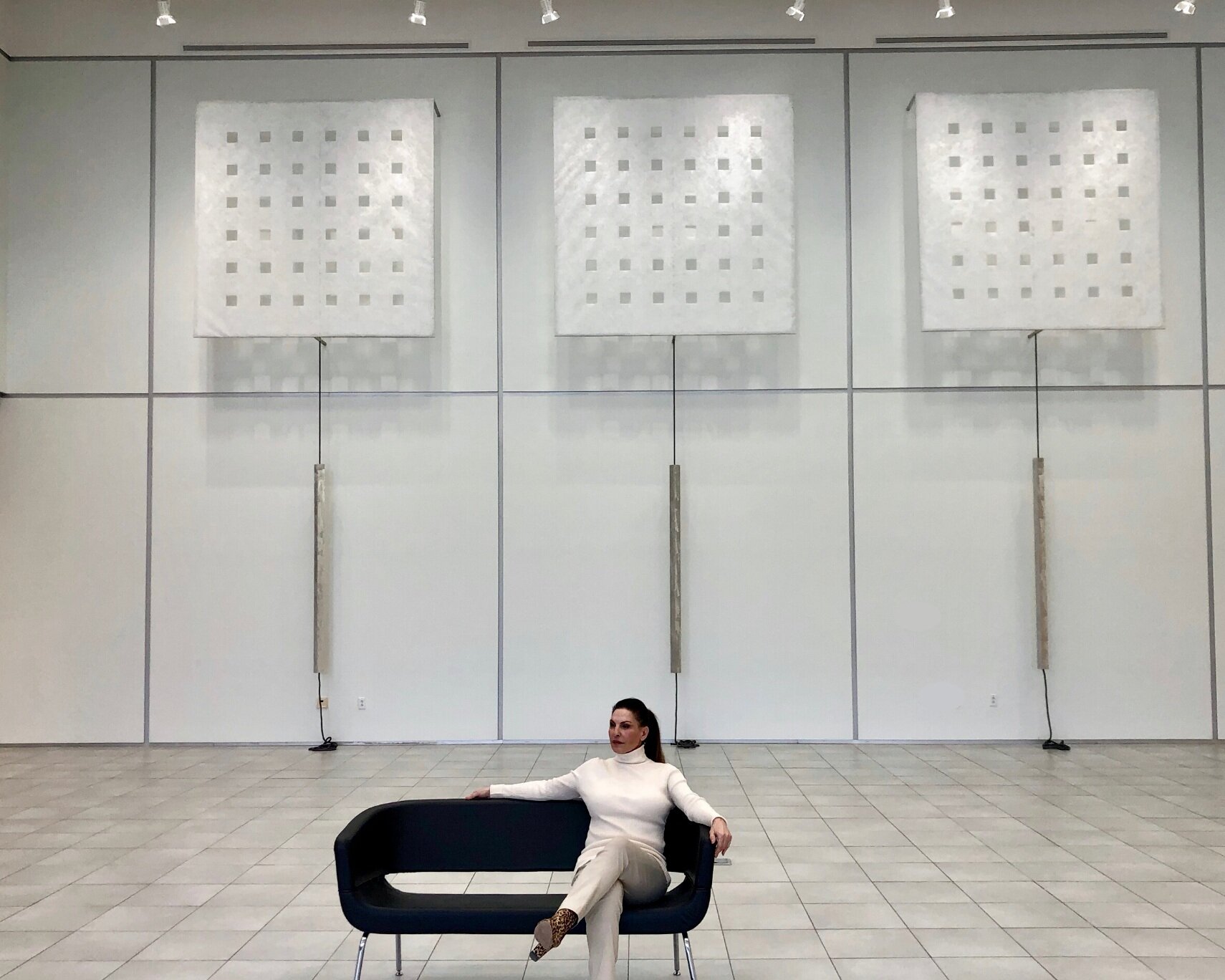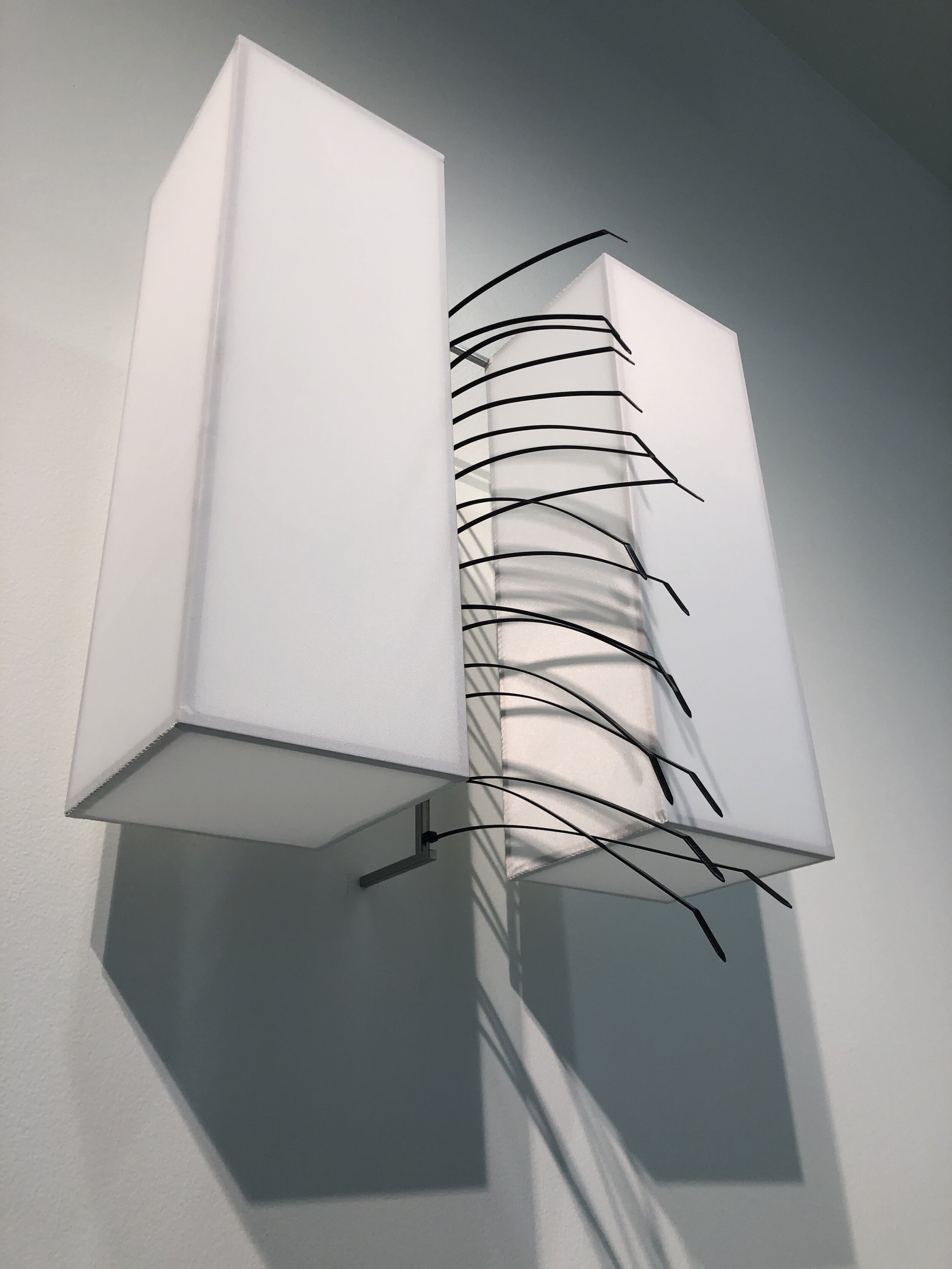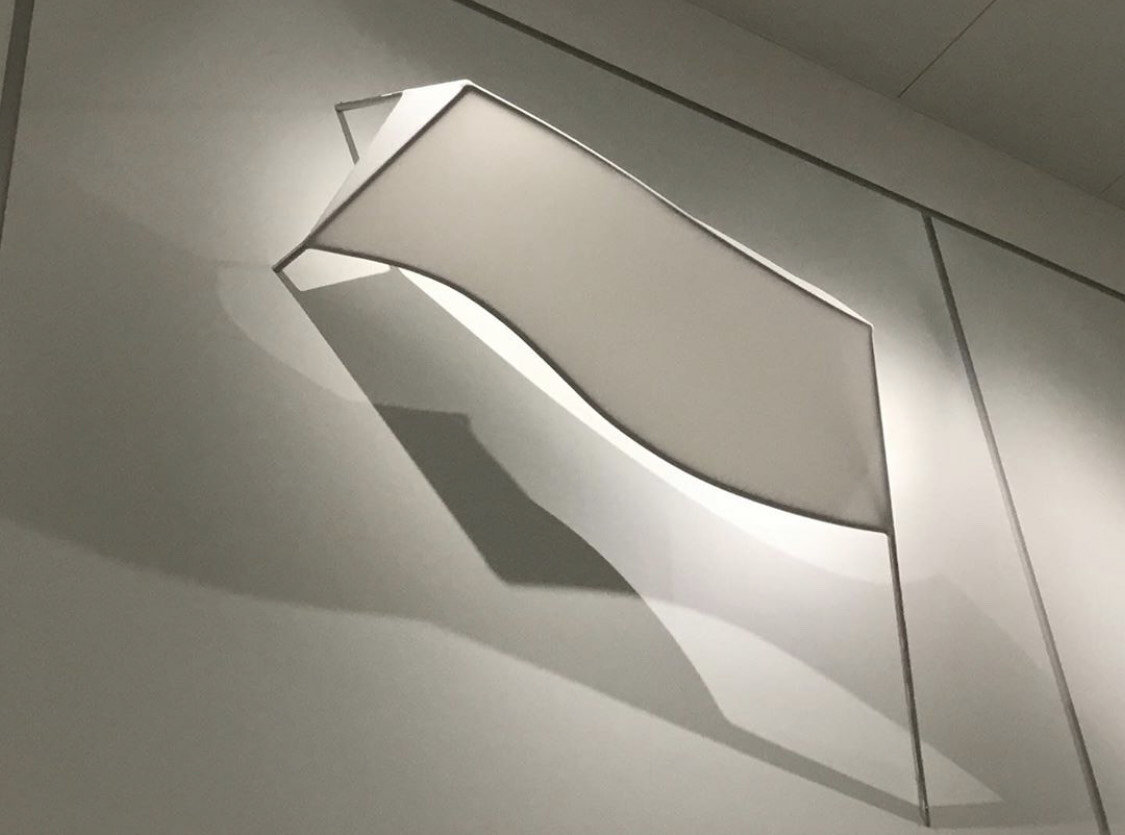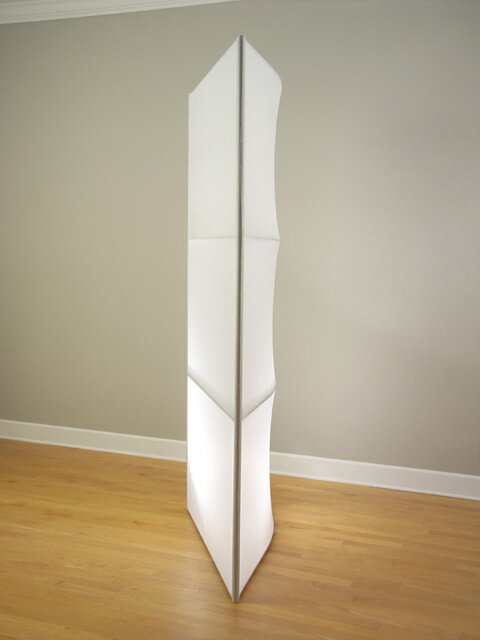Susan Ferrari-Rowley
Selected Works
Line Interrupted Series, Powder Coated Steel and Polyfiber, 36" h x 4" w x 14" d



Squared2 Series 1, 2, 3
All pieces in series are 8 feet high x 8 feet wide x 16 inches deep, Aluminum welded structure, Hand sewn poly fiber fabric and Nylon Rope(Shown installed 20" high on wall) Height can be adjusted.
Can be sold separately.








Ties That Separate 1, 2, 3, 4 All pieces in series are 18"h x 18" w x 14" D Powdercoated Steel, Hand sewn poly fiber fabric #1 shown with artist to scale, #1 side angle



“Linear Compression” 31'w across wall (can be changed to fit site),8' drop with cords,each geometric 6'L, farthest extension off wall 42"



Counterpoise Series: three curvilinear forms. Medium poly fiber and aluminum.
"Balancing Act", 132"H x 135" w x 7"D & extends 77" from wall, Brushed Aluminum and hand sewn polyfiber
"Declaration of Ruin", 156"H x 216" W x 60" D Brushed Aluminum and hand sewn polyfiber,
"And Miles To Go.." 65"H x 156" W x 22"D, Brushed Aluminum and hand sewn polyfiber


How Deep", 84"H x 26"W x 19"D, Brushed Aluminum and hand sewn polyfiber
"Precarious", 84"H X 32.5"W x 17" D, Brushed Aluminum and hand sewn polyfiber,
4-2-2", 10'H x 9'W x 8"D, Brushed Aluminum and hand sewn polyfiber
Entrapped", 8'4"H x 3'3"W x 2'7"D & extends 7" from wall, Brushed Aluminum and hand sewn polyfiber,


Run Through",View 1, 9'6"H x 19" W x 10" extends from wall, Brushed Aluminum and hand sewn polyfiber
Barred", 84"H X 29"W x 36"D, Brushed Aluminum and hand sewn polyfiber,
Strongarmed", 33"H X 25"W x 12"D (shown on 48"H pedestal), Brushed Aluminum and hand sewn polyfiber,
Inseperable"(center) 30.5"H x 25" square, (shown on 48"H pedestal),Brushed Aluminum and hand sewn polyfiber,"Compartmentalized" (right) 30"H x 25"W x 12"D, (shown on 48"H pedestal), Brushed Aluminum and hand sewn polyfiber
About Ferrari-Rowley
Upon moving to Rochester, New York to attend Rochester Institute of Technology acquiring her MST and MFA, the artist Susan Ferrari Rowley found herself in the midst of an arts community that she became a consistent and active part of. Ferrari Rowley played a major role in the acceptance of fabric as a sculptural medium in the art world by consistently pushing the creative envelope and putting her work into competitions that caused critics and judges to question existing standards for what was thought of as a ‘proper medium for sculpture’.
Ferrari Rowley began her career as a sculptor, finding early that fabric was her medium of choice. She quickly discovered that recognition in that medium was restricted to the term craftsman, and questioned being shut out by the sculptural realm that was her works intent. She was accepted into national and international exhibitions such as the International Exhibition at the Tweed Museum of Art with sculpture created with fabric and techniques unique to the handling of such materials, but shortly after, the term ‘soft sculpture’ was coined, appearing to be a setback for those working in this medium.
Ferrari Rowley sited Claes Oldenburg’s soft toilet as an iconic earlier sculpture that had already crossed the barrier in 1966 without creating a stir, and she pushed on, creating larger and more imposing forms with fabric. In 1977 she was one of fifty artists under the age of thirty selected nationally for the exhibition ‘Young Americans: Fiber/Wood/Plastic/Leather’, held once every decade by the American Craft Museum to showcase future leaders in the arts. In this exhibition, her work was helping to coin a new term ‘fine art craft’ for work where the outcome, or the form, was more or equally important than the technique used to create it.
On Sunday, December 16, 1984, New York Time reviewer Phyllis Braff wrote of Ferrari Rowley’s work:….’examples that hold our attention as pure esthetic expressions help to establish the validity of fiber as a fine art medium….her dazzling three dimensional color abstraction, ‘Complementary Movement’ is clearly a star here….the effect is both stimulating and meditative….perhaps the show’s most profound piece……
While the debate over ‘fine art’ and ‘fine art craft’ continued on an international scale, she pushed on,selected in 1988 for ‘Materials: Hard and Soft’ in Texas and The International Art Competition juried byMessinger of MOMA, Satz of the Whitney, and Little from Art in America. Both exhibitions were using work like Ferrari-Rowley’s to erase boundaries. A watershed moment came in 1989 when she entered the‘Chautauqua 32nd National Exhibition of American Art’, with R. Williams of MOMA jurying; ‘NewArt/New Material’ with Bloomer of Yale as one of the luminaries judging; and the ‘International Fiber Exhibition’. Accepted into all, she had purposely entered the same sculpture into Chautauqua and the International Fiber, where it won best of show and purchase for the permanent collection at Chautauqua, and the Brenholz Award for Innovation at the International Fiber. It was at this time, that Ferrari Rowley completed the transition in to the world of Fine Arts with her medium of choice: Fabric.
The Delaware Contemporary Museum selected Ferrari Rowley for a one-person exhibition in 2017,continuing to demonstrate the breadth of her venues. She further expanded her repertoire to outdoor sculpture in coated fabric for exhibitions such as Contemporary Sculpture at Forest Hills Cemetery in Boston, where her massive and innovative ‘Spirit Vessels’ was purchased for the permanent collection. Her outdoor work has expanded to include sheets of perforated plastic and aluminum that mimic the translucency of the fabric of her indoor exhibition work, maintaining her conceptual objectives. The success of this work is evident by her inclusion into outdoor exhibitions at Chautauqua Institute and SculptureNow at The Mount, in Lenox, Massachusetts since 2013.
Additionally, for each major body of work she produced, Ferrari Rowley creates two-dimensional exhibition companion works that are deconstructions of the sculptures. While showing consistently in New York City, she was accepted into the famed international OK Harris Gallery in Manhattan, whose mission was ‘to show the most significant art of our time’. She was selected by the late icon of modern art, Ivan Karp, and completed her third show with them on January 19, 2013 before they closed their doors after 45 years.
She has received recognition from her community, and state, receiving the 2011 NYS Chancellors Award for Excellence in Scholarship and Creative Arts, and the 2013 Visual Artist Award from the Arts &Cultural Council for Greater Rochester.As an adjunct to her sculptural career, Ferrari Rowley began her own company, sfrBOLD, producing ‘sculptural wearables’ in the form of large-scale bracelets and companion pendants.
Currently, Ferrari Rowley continues to excel in the exhibiting of her sculpture, having been in the international 2018 Venice Biennial Sculpture Exhibition, Time/Space/Existence, as one of seven American sculptors included in the this portion of the architecture exhibition, and has been invited back to Venice for the 2020 exhibition. Additionally, she has two major installations opening in 2020, one at Rochester Institute of Technology, NY, and the second at the Public Art Projects Exhibition Space in Cincinnati, Ohio, to mark the grand opening of their newly designed, community based space.











